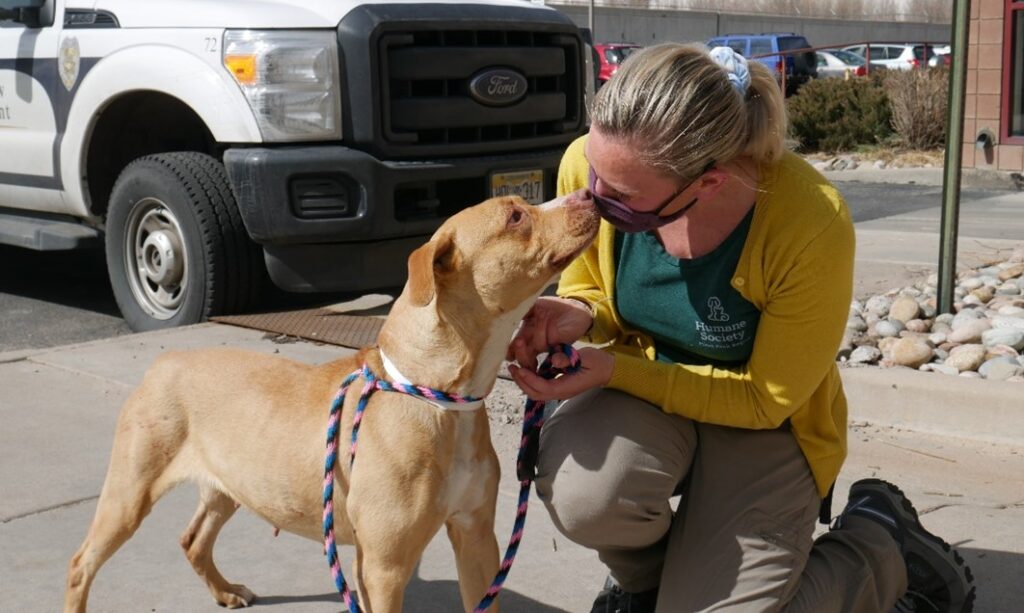
Congratulations! You fell in love with a cute bundle of fur and just adopted him from the shelter. Now you must be wondering what the next steps are to make the transition a successful one for both you and your new pet.
Shelby Harvey, HSPPR’s Certified Behavior Consultant, discusses common mistakes and a few tips to ensure your new pet is set up for success:
- Go too fast with introductions – Whether that is to another dog in the house, a cat, or other members of the household/strangers. New shelter pets can be overwhelmed by all the new things they experience, so it’s best for them to take it as slow as possible.
- What to do instead – When introducing your new dog to a dog that already lives in your household, try to make first contact short, sweet, and controlled. First meets should last less than a minute before a fun encouraging break. Try to have first meets for dogs on leash and preferably through a barrier, like a fence or baby gate. When introducing dogs and cats, have baby gates in the house to give the cats a safe escape route and always have the dog on leash. Give the dog treats for appropriate behaviors around the cats and do not leave the cat and dog unsupervised at any time. Let people in the household know to let the new pet come to them instead of them overwhelming the pet with approaches. Hold off on meeting any friends/family outside of the household until your new pet feels comfortable with your household first.
- Expecting dogs/cats to be house trained too quickly – Shelter pets are going to a new home environment where the litterboxes and outdoors are brand new to them. Routines take a little bit to adjust to as well.
- What to do instead – Give your new pet plenty of opportunities to learn where an appropriate bathroom place is. Make sure the litterbox is in a quiet place that is easy for the cat to see and access. Dogs don’t have the same concept of indoors/outdoors as we do and need to establish a scent-based place to urinate/defecate. Make sure that you have your dog supervised and with plenty of potty breaks. Encourage the dog when he/she does go to the bathroom outside, and try to catch warning signs (pacing, whining, attention seeking) when they may need to go to the bathroom. Do not punish your dog with spanks or yelling whenever they house soiling, as that may increase their anxiety and make the issue worse.
- Taking your dog to a pet store/park/dog wash immediately after leaving the shelter – Having a dog go through a bunch of new experiences at once is called trigger stacking. Trigger stacking is not a great first impression to make with your new dog.
- What to do instead – Keep things as simple as possible and try to go straight from the shelter to a quiet place in your home. Try to have items for your new pet already bought and situated, so you do not need to stop at a store on the way back. When you bring home your new pet, make sure you have a plan and have time set aside to make their transition as easy as possible. Always err on the side of caution of ‘less is more’ of what you expect your new pet to experience and encounter when first bringing them home!
- Letting dogs out into yards unsupervised – Dogs need time to learn their boundaries and also manners for being outside. Leaving dogs unsupervised in your yard can lead to escape tendencies, fence reactivity, and barking excessively, especially within the first couple of weeks.
- What to do instead – Go outside with your dog each time they are outside. You can pull up a lawn chair and relax while still keeping an eye out to make sure your dog isn’t learning bad habits while in the yard. If a new dog learns, within the first couple of weeks, that fence fighting or excessive barking is what they should/can do when outside then it can be really hard to break that habit later on. Dogs (like mentioned before) are more scent based, so they need a little time to establish their scent in the yard. They may also need some reminders from you that trying to dig or jump over the fence is not preferred behavior. You can also help house training by encouraging them whenever they do go bathroom outside. Always give treats when a dog is showing you appropriate manners outside.
- Not giving space for cats to adjust – Giving cats a sanctuary room is the best way you can set them up for success. Having their own space to adjust to will help with introducing them to other cats in the household, and also will help them feel less fearful and overwhelmed.
- What to do instead – Designate a space (preferably a room) to keep your new cat in for the first two weeks. This room should be quiet, have outside light or a window, contain plenty of enrichment, and of course litterbox, food, and water. Keep your visits brief but reoccurring until your new cat feels more at home. If there are other cats in the home, you can introduce their scents to each other by swapping out a towel or toy that they like and then using treats/food and a baby gate to encourage observations of each other without direct physical contact. The slower you introduce cats, the more successful they will be for their future relationship.








